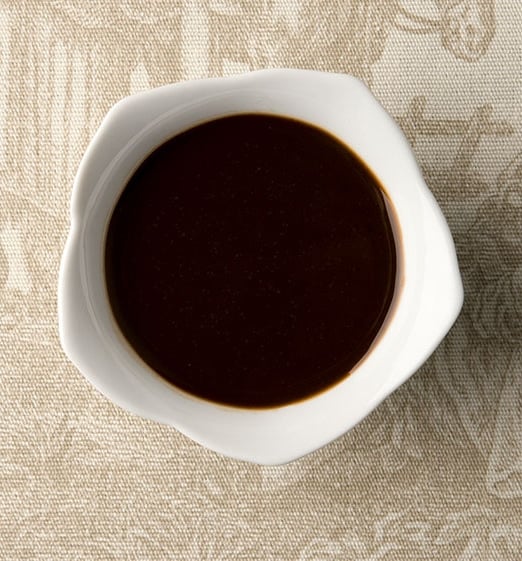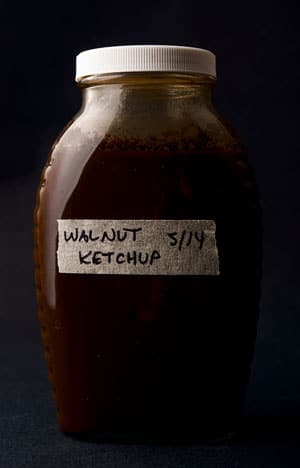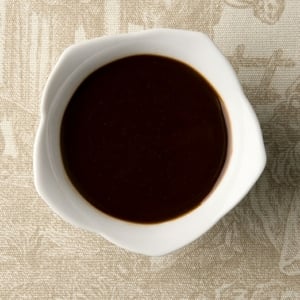As an Amazon Associate I earn from qualifying purchases.

Squirrels love walnuts. So to be a walnut tree, you either need to be fortunate enough to grow where there are no squirrels, or be strong enough to push out lots and lots and lots of walnuts, so the squirrels and jays and yes, people, can have their share. In fact, these virile trees push out so many little nuts that they factor in loss — to not strip some off in springtime stunts those that remain.
That’s where we come in. There are several things you can do with unripe walnuts. My favorite is pickled walnuts. The French and Italians make a liqueur from unripe walnuts, too. And the English make a wonderful sauce from them called walnut ketchup.
This unusual condiment seems to have originated in 1700s Britain, and the word ketchup is either from Chinese or Southeast Asian origin. Back then there were lots of ketchups, and only later did tomato win the tournament as the One True Ketchup. One of the old ketchups was this walnut ketchup.

My recipe is an amalgam of one from 1808 and one from Gourmet magazine from 1948. Basically you mash unripe walnuts, let them steep in vinegar for a week or more, then boil everything with wine, spicy things, anchovies and onion, strain and bottle. Anchovies? Yeah, sounds gnarly. But it isn’t. The sauce isn’t fishy at all, and the anchovies add a savory note to the sauce.
What, then, does walnut ketchup taste like? It’s very sharp, as you might guess from all that vinegar, but beyond the acidity, it tastes like a combination of Worcestershire and A1 Steak sauce. I am not kidding. It really is a dead ringer for A1, but is thin like Worcestershire.

Nowadays there’s no reason not to use this sauce right away. But back in the day, cooks would put up this sauce and store it for at least a year before serving. It needs time to mellow, like wine. Take this note, from Maria Eliza Ketelby Rundell, in her book A New System of Domestic Cooking (1808): “It will keep 20 years in the greatest perfection, but it is not fit for use the first year.”
My advice: Go ahead and use some when you make it. But I can tell you that it really does mellow well after a year. I can’t speak for 20.
Walnut Ketchup
Ingredients
- About 50 green walnuts
- 3 tablespoons kosher salt
- 1 12- ounce bottle malt vinegar
- 3 to 4 cups cider vinegar
- 2 ounces of anchovies, rinsed well
- 1 large onion, chopped
- 1 cup red wine or Port
- 1 teaspoon ground nutmeg
- 2 teaspoons ground black pepper
- 1 teaspoon cayenne
- 1/4 cup chopped or grated horseradish
- A 1-inch piece of ginger, unpeeled and sliced thin
- 1/2 teaspoon xanthan gum (optional)
Instructions
- Crush, chop, crack or grind your walnuts. Remember this is a messy job and the liquid will stain, so your method should reflect that. I wear gloves and a ratty long-sleeved shirt and chop my walnuts small with a stainless steel knife on a dark-stained cutting board, This minimizes the staining.
- Put the walnuts in a large glass or other non-reactive container and cover with the two vinegars. I find it makes a better walnut ketchup with only malt vinegar, but as this can get expensive, you can make do with some malt vinegar balanced with some cider vinegar. Just barely cover the walnuts with the vinegar. Put the lid on the container and let this sit at room temperature for 8 days.
- After 8 days, move the walnuts and vinegar into a large, non-reactive pot and add the remaining ingredients. Boil gently for 45 minutes, then strain through a fine-mesh sieve to separate the solids. As an extra step, you can wait until the sauce cools and then buzz the sauce in a blender with the xanthan gum; this will keep the very fine solids suspended in the ketchup and give you a sauce with more body.
- Bottle the sauce and keep it in a cool, dark place indefinitely.
Nutrition information is automatically calculated, so should only be used as an approximation.





Used some of the walnuts I brined for pickled walnuts.
Like you I combined some recipes and used available spices.
Which from the found recipes variety it looks like whatever you have in the pantry. It definitely needed some time on the shelf. After 5 months mine is more like worchestershire than A1. The pickled walnuts after 5 months are like solid chunks of strong worchestershire in a good way if used judiciously.
Will be making both of them again modifying the recipe in the years that my low limbed walnut tree bears nuts. Not planning on using the extension ladder for it since I think one year’s batch will yield several years worth. Though my friends at a sportsmen’s club will take any overflow.
Hi Hank,
I tried your recipe. Do I need to refrigerate to store? Or can I set on the shelf for those 20 years? Thanks!
Bob: It is shelf stable.
Really good after waiting 3 months to try it. It was fun to make, too.
Oh darn, I wish I’d seen this recipe b4 we threw out the nuts whose shells were starting to form when we made the pickled walnut recipe! (One month to go on the pickles, so looking forward to trying them!)
I can’t rate this recipe b/c I haven’t tried it, but I’m sure it’s awesome 🙂
Just on a whim, have you ever made this with mature walnuts? I love the idea of this sauce, and always have a bag of walnuts on hand, but don’t know where I can find immature green ones. Just thought I’d ask…
I am currently picking green walnuts over here in England with the aim of following this recipe but the fruit that I am currently coming across appears to have been impacted by walnut blight with several black spots forming on the fruit. Would you still use them?
Great site by the way, glad that I came across it!
I made a batch last year from this recipe. I ended up adding maybe 6-8 ounces of date paste (that I had in the freezer) to add a bit of depth and sweetness. And damned if it didn’t taste like all the best parts of A1, and better! We’ll be making more this year for sure!
Hi Hank, have you ever tried steeping the walnuts more than once? I made Nocino this year and just decided on a whim to strain out the solids and re-steep them in simple syrup to make a dessert topping. It was so good, I did it again and I am currently on my third steeping without any perceived loss of quality!
Love the clarity and detail in your recipes! I have allergies to apples and all seafood (e.g., anchovies), so was glad to read that it’s even better to replace the cider vinegar with more malt vinegar, which I love. Any suggestions for a substitute for the anchovies, or just leave them out? This sounds SO good! Thank you.
Laura: Try adding some mushrooms instead of the anchovies.
I make a walnut ketchup similar to this and mine is gluten free. My brother is Celiac, so I am very careful with what I put in. I use muselmans apple cider vinegar that is marked gluten free. I also use shallots instead of onion because of the flavor. I just picked my black walnuts the last day of July. It was a late season and the walnuts were too small in June.
I fill a 5 gallon bucket with walnuts plus 2 cups of salt, fill with water and soak for a week. Keeping that liquid, I take out the walnuts and smash them into mush. In a different bucket I cover the mush with boiling vinegar. That soaks for a week. I combine the liquids and this goes through a nylon brewers bag.
Then I boil it down to 2 gallons on a wood fire in the back yard because it is hotter than my stove.
When reduced, I add 150 ml Port, shallots, cayenne pepper, hot paprika, anchovies, ground mace, nutmeg, cloves, fresh ginger, peppercorns, fresh raw horse radish. One batch needed more salt believe it or not, so spice to taste. This sits for 3 days, and then I put it through my blender. I bottle it in new sauce bottles and it is good for about 2 years in the fridge. But mine never lasts that long. -kevin
Hi Hank,
Is their anyway of substituting the malt vinegar for a gluten free
sauce. I ask as I have used your excellent jerky marinade mixture but a family friend is gluten intolerant.
Many thnks for the wonderful recipes.
Greg
Greg: Absolutely. Just use a different vinegar.
Ok, thanks!
Hank, would it be possible to immersion blend the sauce instead of straining it to get a thicker sauce, or is that a Bad Idea?
Kurt: Yes, but it will separate unless you use some xanthan gum.
Hank thank you for clarifying and also helping me really understand what I needed to do. Went to the kitchen with a big quilting needle and it would not go all the way through. Above it does say you can use slightly older ones were the shell is just forming. I am guessing if the needle is stuck then that is too much shell. Well that will give me something to look forward to in the spring. So I guess I will move on to Brined Carrots!!! Thanks and really looking forward to other recipes.
Hank,
I amy be missing something, sorry but I am a little unclear. So I took a green walnut and stepped on it to look inside. Yep, some walnut pieces but no shell yet. But there is the green outer layer, mine is more bumpy than in your photo, yours look smooth. So do the green parts go in? The whole things gets chopped up and then soaked in vinegar? All parts, nothing removed?
I am looking forward to this and I have gather some more walnuts but I will probably use a ladder and a broom to knock down a few more, and probable pilfer from my neighbors yard.
Elizabeth. Yes, the whole thing. But jam a needle through your walnuts first. They should go right through. If they hit shell, you are too late and need to try again next year.
Have you ever tried making hickory ketchup?
Anna: Nope. I think the shells might be a problem. Hickory husks are different from walnut husks. Maybe if you got to the nuts very early it might work.
HI there! I’ve tried pickled green walnuts before and wasn’t happy with the results. But when I saw your post I decided to give green walnuts another chance. 🙂
I just picked about one pound (16 walnuts, some quite small.) So if I do the math, your 50 walnuts weighed between 3-4 pounds? Do you suggest: dividing your recipe ingredients in quarters or in thirds for one pound of green nuts? My walnuts are English BTW.
Thanks!!
Laurel: Try cutting it in thirds first. Better to have a little too much pickling liquid than too little.
Where in the U.S. do you find green walnuts? when you crush/chop/crack the walnuts do the shells do into the vinegar also?
Rebecca: All around you. They are just the unripe nuts on any walnut tree, cultivated or wild. You do this when the shell hasn’t really formed, so yes, you use the whole thing.
How coarse of a chop on the green walnuts? When I make nocino I just quarter them — are you going for something finer here?
David: I chop pretty well, until I get chunks the size of your fingernail.
My take on this: https://dangermencooking.blogspot.com/2003/08/recipe-below-is-not-really.html